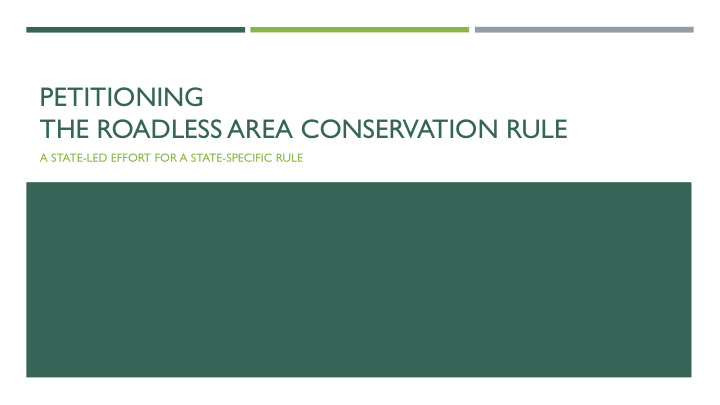



PETITIONING THE ROADLESS AREA CONSERVATION RULE A STATE-LED EFFORT FOR A STATE-SPECIFIC RULE
2001 ROADLESS RULE Adopted January 2001 Protects social and ecological values and characteristics of inventoried roadless areas (IRAs) from road construction and reconstruction and certain timber harvest activities. These have the greatest likelihood of altering or fracturing landscapes, resulting in immediate and long-term loss of roadless area values Activities are not prohibited but are restricted 49 percent of Utah’s National Forests are designated as Roadless
Roadless Areas within the CWC focus area
EXCEPTIONS IN THE 2001 RULE Exceptions to road construction Exceptions to timber harvest prohibition prohibition T o protect public health and safety T o improve endangered, proposed, sensitive species habitat CERCLA response T o maintain or restore characteristics of the ecosystem Reserved or outstanding rights Incidental to another activity that is not otherwise Road safety improvement prohibited Prevent irreparable resource damage For personal or administrative use In conjunction with pre-2001 mineral leases IRA characteristics have been substantially altered by road construction and timber cutting within certain parameters
WHY DOES UTAH WANT A STATE-SPECIFIC RULE? Give the local Forest Service districts more flexibility to manage the unique challenges in Utah’s roadless areas, promote healthy forests, and mitigate catastrophic wildfires. Many of Utah roadless forests suffer from bark beetle-infestations, excessive buildup of deadfall and ladder fuels, excessive tree density, pinyon-juniper encroachment into sagebrush habitat, and other symptoms of poor forest health. These conditions can impair watershed health, degrade wildlife habitat, and increase risks of catastrophic wildfires. Catastrophic wildfires pose extreme risks to Utah’s air quality, water quality, wildlife, recreation, and private property in the “wildland - urban interface.” A state-specific roadless rule could give the Forest Service greater flexibility to remove deadfall and ladder fuels, cut beetle-infested trees, minimize pinyon-juniper encroachment, and thin overgrown stands in Forest Service roadless areas. Such projects in roadless areas will help safeguard Utah’s watersheds, air quality, wildlife, and resiliency to catastrophic wildfires.
PROCESS Prepare Petition • County, Agency Submit Petition recommendations • USDA Review • County RMP EIS Analysis amendment • Potential revisions • Stakeholder outreach • Acceptance • Listening sessions June – December 2018 December 14, 2018 2019 - ?
WHAT MAY CHANGE UNDER A STATE-SPECIFIC RULE Three management categories 1: Primitive Areas : same management as 2001 Rule (no change) 2: Forest Restoration Areas (moderately restrictive) 3: Forest Stewardship Areas (least restrictive) Re-inventory or boundary adjustment
WHAT WILL NOT CHANGE Land remains under jurisdiction of US Forest Service NEPA reviews will still be required for projects Motorized travel must follow each Forest’s Travel Management Plan Access to mineral extractions is limited to pre-2001 permits Wilderness or other land use designations remain
PUBLIC LISTENING SESSIONS October 18 October 24 Monticello Heber October 23 October 25 Vernal Manti October 24 October 30 Richfield Cedar City
QUESTIONS? Brianne Emery 801-537-9844 OurForests@utah.gov
Recommend
More recommend